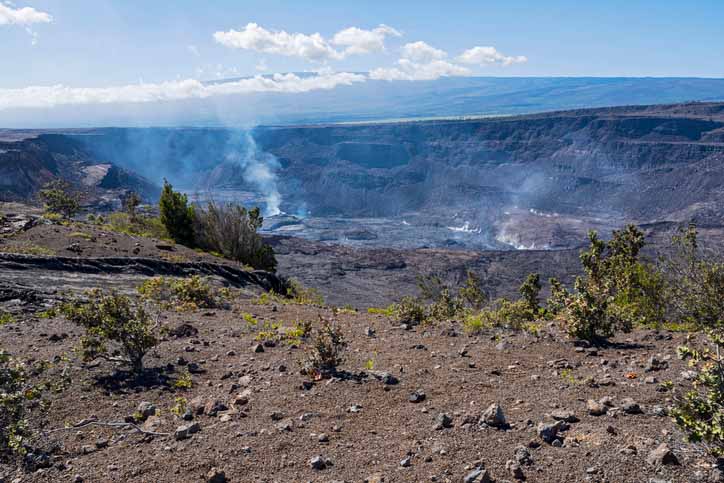Ash and volcanic smog (vog) are hazardous to your health
When a volcano is exploding and volcanic smog (vog) is present or ash is falling, stay indoors whenever possible to protect your lungs. If you must be outside, wear an N95 mask to filter out the particles from your airways.
Even though Kilauea is on the south end of the Big Island, the reach of the ash cloud and vog can travel far. During particularly active times, that cloud can stretch far beyond the shores of the Big Island and can reach Maui and Oahu.
Sulfur Dioxide, the main gas released, is one of the chemicals trapped in lava that are then released as gas when exposed to atmospheric surface pressure. The more lava that boils up from below, the more gas will be released. These gas emissions, or volcanic air pollution, are what we know as “vog.” The sulfur dioxide gas and sulfuric acid mist are then carried downwind, often to the southern area of the island and then up the western coast to Kona and possibly beyond.
Pele’s Hair is beautiful and dangerous
Though Pele’s hair doesn’t travel nearly as far as vog and ash, it, too, is a hazard to those who come across it. When bubbles of love come up to the surface and explode, droplets fly out and develop a tail as they harden. These then form long strands of volcanic glass that carpet the ground. When seen in the early morning or as the sun sets, they look like dried golden wheat. Though it is quite beautiful, the glass is very sharp and can easily injure both people and animals.
Kilauea Volcano forms the southeast side of the Big Island
The Big Island of Hawaii is formed by five overlapping volcanoes with the youngest, a shield volcano named Kilauea, on the southeast side of the island. The volcano started erupting on the ocean floor between 300,000 to 600,000 years ago and is now the home of Pele, the Goddess of fire and volcanos.
The epicenter of the volcano slowly grew with sloping sides but collapsed around 500 years ago forming Halema’uma’u Crater in what is now Hawaii Volcanos National Park. In the 1920s, the size of the crater doubled and the volcano has been active on and off for the last 100 years, with lava coming to the surface yet again starting in 2008. It was that day in the early morning of March 19, 2008 that the volcano exploded and blew a hole in the side of the crater 100 feet wide with lava just below the surface. Over the years, this lava lake has grown significantly in size, sometimes spilling over, and sometimes dropping down.
In 2018, Kilauea erupted once more, forming new fissures in the earth where lava erupted out and formed rivers of rock, destroying over 700 structures and adding 837 acres of land to the island. The lava in the crater has become more active again in 2023, spilling over the banks of the lava lake and forming a new cone about two stories high.
Scientists use Kilauea to study volcanos
Kilauea has been a center of study for volcanos due to its high activity. Scientists can tell a lot about what a volcano is doing based on the amount of ash falling to the ground and the ash’s chemical composition. They also take measurements of gas emissions and with this information, are able to learn more about how volcanos work and how to better protect the lives of those in a volcano’s path.
When scientists go near the rim of the crater to work with equipment or take measurements, they wear half-faced breathing masks to protect their health.
Always keep masks on hand
Over this last month, lava has again been erupting from the surface and releasing ash and vog. Even though it has quieted down for a time, you can still see sparks of lava at night and continual gas emissions from lava flowing just below the new crust of the lake. Whether you live nearby on the Big Island or you live on Maui or Oahu, it is wise to always have some masks at home to protect yourself and your family the next time Pele awakens.


